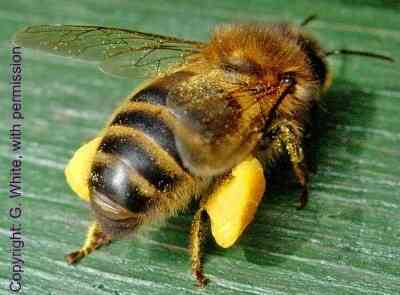Honey Bee Foraging Behaviour And Preference Of Pollen Sources
It is well enough known and observed that bees forage on a variety of different plants. It is also observed that bees will vary the plants on which they forage during the day. Sampat Ghosh and his colleagues1 propose that a key priority for honey bees when they are selecting which plants to forage is the protein content of the pollen.
Why is this important?
According to the researchers, understanding the reasons that bees choose some plants over others may assist those who manage pollinator protection programs to create the most appropriate environment for bees, and ensure that important bee nutrition resources are not absent from the environment – especially the agricultural environment that depends on honey bee pollination.
Well, I'm all in favor of that! I might also add that for ordinary householders keen to create a bee garden, it further emphasizes the importance of flower selection, and in particular, choosing flowers that offer both nectar and pollen for bees.
Do honey bees prefer some pollens over others?

Honey bees collect pollen and nectar for their own individual nutrient requirements, but also for the nutritional requirements of other members of the hive (including any larvae). They take nectar (from which they produce honey) as an energy source, and pollen for their protein, lipids and other micronutrients.
Ghosh and his team were interested to discover whether or not honey bees forage on plants with pollen of high protein concentration.
To investigate this question, they observed the foraging behaviour of three hives of honey bees over a three-day period.
For the duration of the study, it was found that all three colonies collected
the greater proportion of pollen from just four plants, despite the availability of other flowers:
Is protein relevant in pollen selection by bees?
Proteins are comprised of a variety of amino acids. Interestingly, it is known that the pollens from all of the four plants mentioned above each contain all ten of the amino acids that are considered essential for honey bees2.
These essential amino acids are: Leucine, Valine, Isoleucine, Methionine, Lysine, Threonine, Histidine, Phenylalanine, Arginine, and Tryptophan.
However, the proportion of amino acids within the pollen varied within each of the four plant species mentioned above.
Interestingly, Ghosh et al found that the bees from all three colonies collected pollen mostly from white clover (Trifolium repens), although relative floral abundance of each of the flowers types is not clear from the study.
Interestingly, despite less pollen gathered from Coreopsis drummondii, it contained a proportionately high level of amino acids.
| Plant | Amount Of Pollen Collect (mg) (Total from all 3 colonies) | Total Amino Acid Content (g/100 g dry matter) |
|---|---|---|
| Trifolium repens | Around 13,500mg | 19.97 g/100 g pollen |
| Erigeron annus | Around 8,000 mg | 9.67 g/100 g pollen |
| Coreopsis drummondii | Around 13,500 mg | 11.44 g/100 g pollen |
| Oenothera biennis | Around 1,200 mg | 8.89 g/100 g pollen |
Among the essential amino acids, leucine and lysine was found predominating and among the non-essential amino acids glutamic acid was found the most abundant.
It should be noted that pollen and its various amino acids, is vital for honey bee colony development and health.
Conclusion
The researchers conclude:
"The amount of pollen collections were found to exhibit the relation to the colony’s need which was indicated by the number of larval and adult bees present in the hive.
Further, the results revealed that honey bees foraged the pollens with higher protein content.
However, protein and amino acid is not the only component responsible for the well-being of the honey bee and thus exploring the interaction with other nutrients especially macronutrients is also important in the context."
Comment
I have long advocated clover for bees, since it is clearly a favorite and a rich food source. Councils could easily convert many manicured grassy areas into fragrant clover lawns, and clover offers opportunities for gardeners too, especially as a method to create a bee-friendly lawn that is also easy to maintain.
In view of this, it was interesting to note that clover offers bees a rich source of amino acids.
The abundance of each of the flowers relative to each other is not clear from the study, but clover usually grows in large swathes, and this may have impacted the results, yet the availability of this fragrant wildflower of the pea-family, offers valuable nutrients that are bound to make it a favorite in many cases.
Whilst clover was a clear winner, it’s clear that both Coreopsis drummondii and Erigeron annus were popular and nutritionally valuable for bees (the former especially so). Both plants belong to the Asteracea plant family which includes many favourites for bees, such as sunflowers and of course coneflowers.
References:
1. Ghosh, S., Jeon, H. & Jung, C. Foraging behaviour and preference of pollen sources by honey bee (Apis mellifera) relative to protein contents. j ecology environ 44, 4 (2020). https://doi.org/10.1186/s41610-020-0149-9
2. de Groot, A.P. Amino acid requirements for growth of the honeybee (Apis mellifica L.). Experientia 8, 192–194 (1952). https://doi.org/10.1007/BF02173740
If you found this page helpful or interesting, I'd really be grateful if you would share it with others - if not this page, perhaps another, such as Gardening For Bees.
Thank you so much :) .